Unfortunately, no gardener is immune from the problems that may arise when growing strawberries, for example, for some reason it may not bloom or turn yellow. In order to help the plant to cope with the disease, you need to be able to correctly determine the cause of its occurrence.
The difficulty of this task lies in the fact that one and the same sign can characterize several defects at once. In this case, it is necessary to analyze all the conditions of the plant.
Suffer most often above ground part strawberries. The most common problems of all summer residents are as follows:
- lack of flowering;
- redness or yellowing of the foliage;
- drying of the green part of the bush.
Table of contents
Why the strawberry does not bloom or does not give berries?
Growing strawberries, each gardener can face such a problem as the lack of flowering, which in turn leads to crop loss.
There are many reasons for which the plant ceases to bloom, berries do not start to grow or start giving empty flowers and in order to know how to correct the problem, you need to determine what exactly the bushes are disturbing.
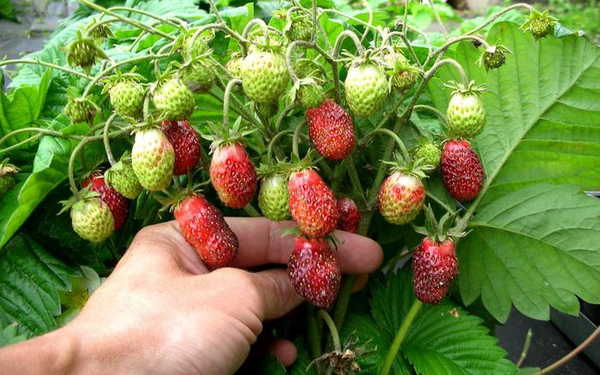
Improper fit
Time for work is desirable to choose in accordance with the climatic conditions in the region:
- In localities with early winter and cold autumn, seedlings are planted in the ridges in mid-August to avoid damage by early frosts. By this time, the bush will have time to build up a powerful root system and will be ready for the cold;
- In that case, when winter comes late and accompanied by sufficiently warm temperatures, it is better to designate the landing at the beginning of September;
- The safest option would be a spring planting, but in this case, the crop will appear only after a year.
It is very important to take into account the fact that flower buds not laid in the shadowsso you need to grow strawberries in sunny areas.
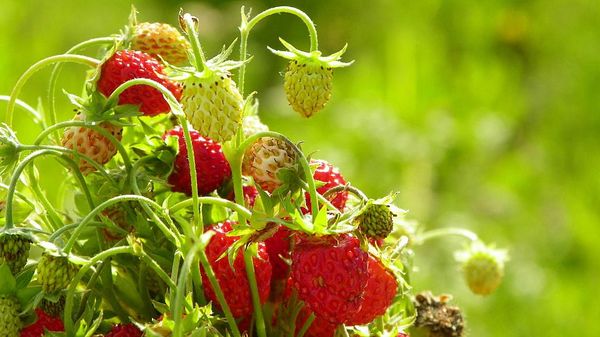
Another significant moment will be the process of planting, in which the heart cannot be buried. Otherwise, the bush will begin to dry, wilt and will not be able to form buds. If a similar error was discovered after the work, the heart can be carefully excavated.
Improper care or unfavorable climate
In order to get a stable crop you must comply strawberry cultivation and select varieties suitable for cultivation in a particular region.
The most common lack of colors can be due to the following reasons:
- An excessive amount of nitrogen fertilizers leads to the fact that the garden plant is actively growing foliage, but at the same time flower buds develop poorly. If a similar problem was discovered, then in the beginning of summer it is worth removing half the green mass and depositing phosphorus-potassium supplements;
- Strawberries need water regularly throughout the vegetative period (from early spring to mid-autumn). The soil should be wet, the formation of a dry crust is not allowed;
- Such a culture bad fruits on clay soilsIn this case, before planting, sand and humus are introduced under digging, and additional drainage is also possible. Excessive moistening of the roots can also become an obstacle to the formation of buds, so small bulk mounds are often constructed for the beds.
- After 4 years, almost all varieties of this crop lose the ability to fully bear fruit, so the planting should be updated on time;
- If the winter is cold, but with little snow, there is a very high probability that the flower buds will freeze.To prevent this from happening, the plant covered with dry straw, spruce or agrofibre. It is also recommended to throw on the landing additional snow layer;
- Return spring frosts can destroy the existing flower stalks. With the threat of freezing temperatures the bushes are covered with a film or cellophane. In the morning, such protection is necessarily removed.
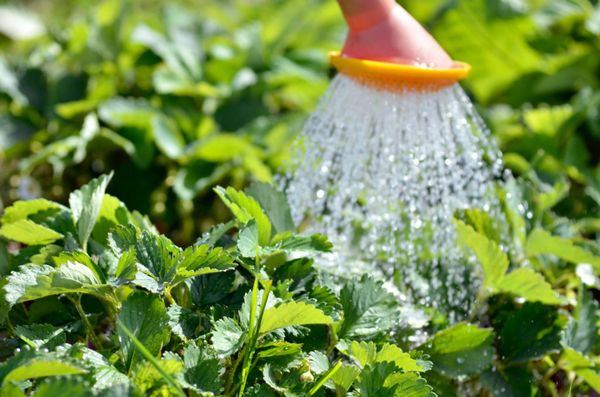
If there are no flowers on a strawberry, then first of all it is necessary to analyze all possible reasons, find the right one and try to eliminate it.
Why do strawberries turn yellow, leaves turn pale and what to do?
One of the main problems that most novice gardeners face is the wrong planting of plants, during which the following common mistakes are made, you need to know what to do if the leaves start to curl, roll up or turn black:
- Strawberry doesn't like shadowbut open sun rays can burn the leaves, causing yellow spots;
- It is not allowed to grow a culture on sour soil. Experienced gardeners do not recommend planting strawberries in those areas where tulips, raspberries, nightshade or aster cultures grew before it. Strawberries may turn yellow or brighten.
- The distance between the bushes should be not less than 25-30 centimeters. If too close, the leaves shade each other, causing the plant to wilt.
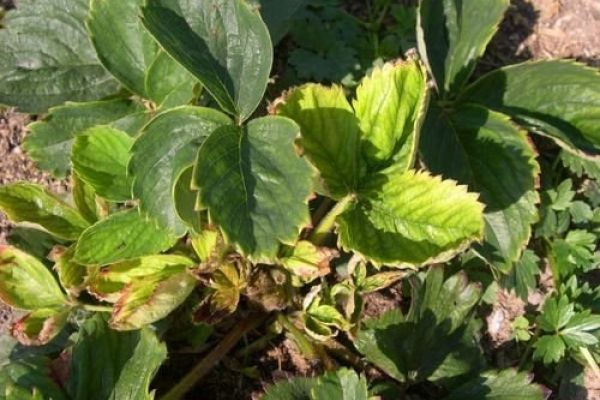
Yellow foliage may be associated with insufficient watering. Strawberries should be moistened as the soil dries, using 10-12 liters of water per 1 square meter of planting.
Lack of any of batteries can also be a serious problem. If the plant receives an insufficient amount of magnesium, then the leaves become brown, yellow or purple. At the same time, cell death at the sites of damage is characteristic.
In order to get rid of this disease, the soil is watered with a solution of magnesium sulfate, a week later, the procedure must be repeated.
Lemon colored leaves indicate that the plant not enough nitrogen. In this case, it is necessary as soon as possible to fertilize strawberries with ammonium nitrate.
If in the spring yellow spots appear on the streaks of the leaves, infectious chlorosis. The disease occurs due to the fact that the soil warms up slowly enough and in such conditions the roots are harder to absorb moisture and there is no possibility to actively absorb nutrients.
In order to help the plant survive this difficult period, it is watered with warm water and periodically sprayed with a solution of iron.

Another cause of yellowing or pale leaves can be a variety of pests that affect the aboveground part of the plant and the roots. In addition, many of them are carriers of dangerous infections.
Most often on strawberries can be found:
- May beetle;
- spider mite;
- Sickling pennits.
To save the plant from pests need to treat it with the drug Fitoverm. The first treatment is carried out shortly before the formation of buds, then after 2 weeks the procedure is repeated.
If insects have settled in the soil, then it is shed with a solution of potassium permanganate, 5 grams of which is diluted in 10 liters of water.
What to do if the leaves began to blush

Strawberry is characterized by autumnal wilting of the foliage, in which it first blush and then gradually dries out.
Types of red spots
On this culture, you can find various types of spots that are accompanied by the appearance of red, crimson and purple spots:
- With white spotting, small specks very quickly grow and become light, but at the same time they have a red or brown rim. Perhaps the appearance of whitish plaque;
- With brown spot, the focus of the disease is located at the edge of the leaf. The spots are large, painted red, burgundy or brown with a rim;
- In case of brown spot, continuous spots without a rim appear, which grow very quickly, hitting the whole leaf, thereby causing its dying off.Unlike other types of diseases, brown spotting also affects the whiskers and stalks.
Red magenta stains may occur due to too acidic soil. In this case, there are no signs of drying.
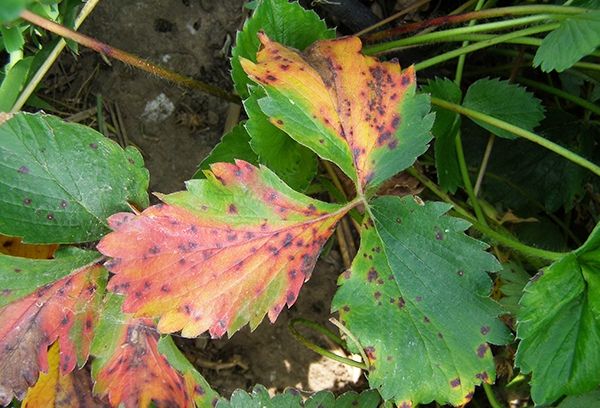
Any kind of spotting is easier to prevent than to cure. To do this, it is necessary to observe the agrotechnical cultivation, time to clean the area from weeds, to remove damaged parts of plants and update planting every 3-5 years.
In the event that the disease still appeared, perform the following actions:
- first you need trim the affected leaves, mustache and stalks.
- early spring plants treated with Bordeaux mixturewhich can be replaced with a solution of ammonia, potassium permanganate or brilliant green;
- the second treatment procedure is carried out after harvest;
- You can finally get rid of the infection with the help of the last treatment at the end of September.
What is the reason that the leaves dry
With improper care and damage to the plant by diseases and insects, the leaves begin to dry, they can spin or twist and gradually die off.
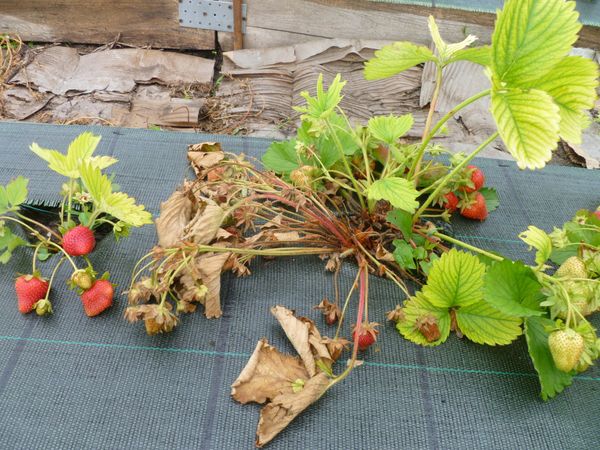
Usually, dry strawberry leaves can be found under the following circumstances:
- Brown spot - initially on the edges of the leaves appear red-brown spots, which gradually grow. In August-September, the above-ground part of such plants dries and dies;
- Also the drying of the foliage may be due to the appearance white or brown spot;
- Rust - yellow-brown spots appear on the leaves, on which spores of the fungus can be seen, as soon as the ailment covers more than half of the plate, it will gradually dry;
- Phytophtoric wilting - this disease can lead to the complete death of the plant. A characteristic feature is the redness of the central root. Initially, only the lower leaves dry up, but then late blight spreads to the entire shrub. The most common reason for drying the above-ground part of strawberries will be the lack of timely watering on hot and dry days.
- If a strawberry leaf beetle or whitefly appeared on the bush, then on the leaf blade one can find sinuous traces of these insects that feed on juicy pulp. Damaged parts of the plant can be twisted in a boat, dry up and die.
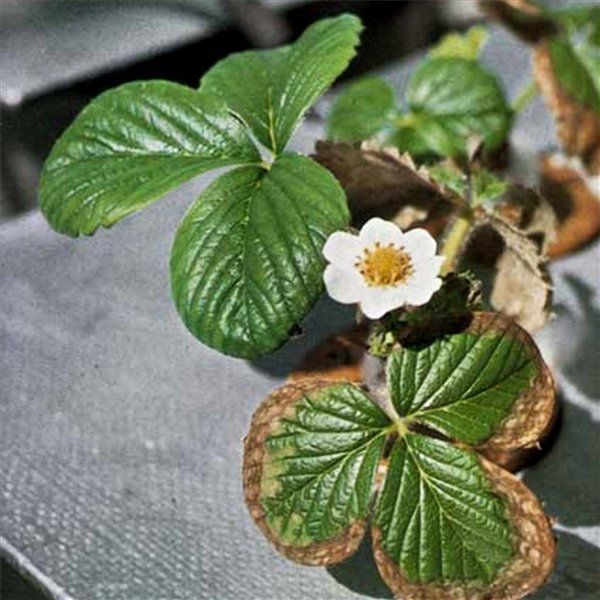
After identifying the causes of strawberry leaves drying, you can take active steps to eliminate the existing problem:
- first need adjust wateringIt must be stable and timely. It is advisable to use warm water and immediately slightly loosen the soil. Such work will be an additional prevention of fungal diseases;
- when insects appear, the bushes are treated with various insecticides;
- to get rid of diseases three times per season strawberries are treated with fungicides or Bordeaux mixture. The first treatment is carried out immediately after the appearance of the first leaves, the second after picking the berries, and the third during the preparation for winter;
- regardless of the cause of leaves drying, all affected parts must be removed and disposed of.
In order not to meet with various problems of growing strawberries, it is sufficient to properly care for her and perform all the necessary work. If the plant was planted to meet all requirements, and watering, fertilizing and other procedures are performed regularly and in the right quantity, the risk of lack of flowering, drying, yellowing or redness of the leaves is minimized.
